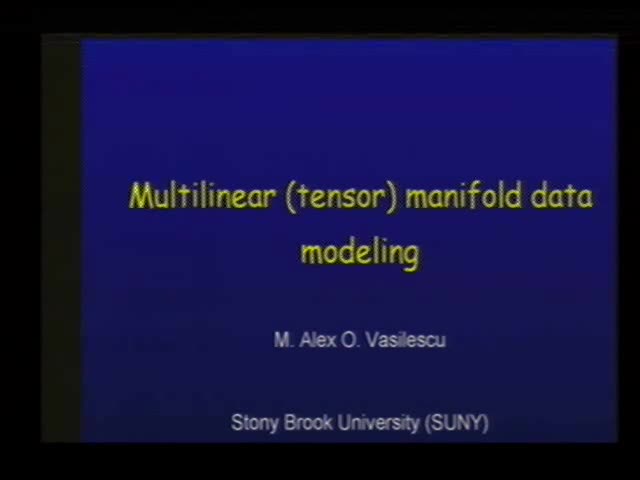Multilinear (tensor) manifold data modeling
Presenter
October 28, 2008
Keywords:
- Multilinear
MSC:
- 47A07
Abstract
Most observable data such as images, videos, human motion capture
data, and speech are the result of multiple factors (hidden
variables) that are not directly measurable, but which are of
interest in data analysis. In the context of computer vision and
graphics, we deal with natural images, which are the consequence
of multiple factors related to scene structure, illumination, and
imaging. Multilinear algebra offers a potent mathematical
framework for extracting and explicitly representing the
multifactor structure of image datasets.
I will present two multilinear models for learning (nonlinear)
manifold representations of image ensembles in which the multiple
constituent factors (or modes) are disentangled and analyzed
explicitly. Our nonlinear models are computed via a tensor
decomposition, known as the M-mode SVD, which is an extension to
tensors of the conventional matrix singular value
decomposition (SVD), or through a generalization of
conventional (linear) ICA called Multilinear Independent
Components Analysis (MICA).
I will demonstrate the potency of our novel statistical learning
approach in the context of facial image biometrics, where the
relevant factors include different facial geometries,
expressions, lighting conditions, and viewpoints. When applied to
the difficult problem of automated face recognition, our
multilinear representations, called TensorFaces (M-mode PCA) and
Independent TensorFaces (MICA), yields significantly improved
recognition rates relative to the standard PCA and ICA
approaches. Recognition is achieved with a novel Multilinear
Projection Operator.
Bio:
M. Alex O. Vasilescu is an Assistant Professor of Computer
Science at Stony Brook University (SUNY). She received her
education at MIT and the University of Toronto. She was a
research scientist at the MIT Media Lab from 2005-07 and at New
York University's Courant Insitute from 2001-05. She has also
done research at IBM, Intel, Compaq, and Schlumberger
corporations, and at the MIT Artificial Intelligence Lab. She has
published papers in computer vision and computer graphics,
particularly in the areas of face recognition, human motion
analysis/synthesis, image-based rendering, and physics-based
modeling (deformable models). She has given several invited talks
about her work and has several patents pending. Her face
recognition research, known as TensorFaces, has been funded by
the TSWG, the Department of Defense's Combating Terrorism Support
Program. She was named by MIT's Technology Review Magazine to
their 2003 TR100 List of Top 100 Young Innovators.
http://www.cs.sunysb.edu/~maov
